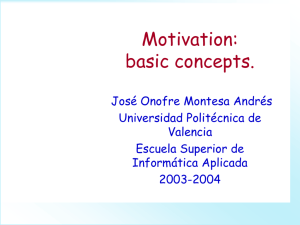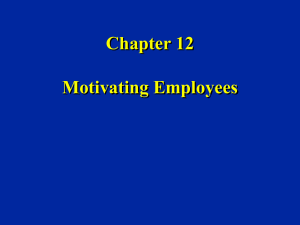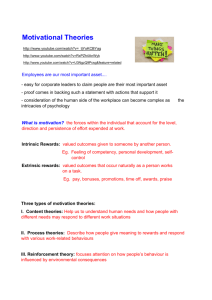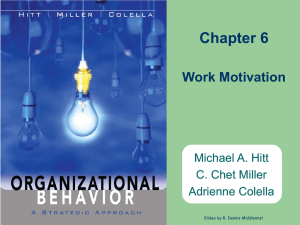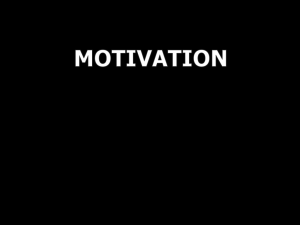Management 9e
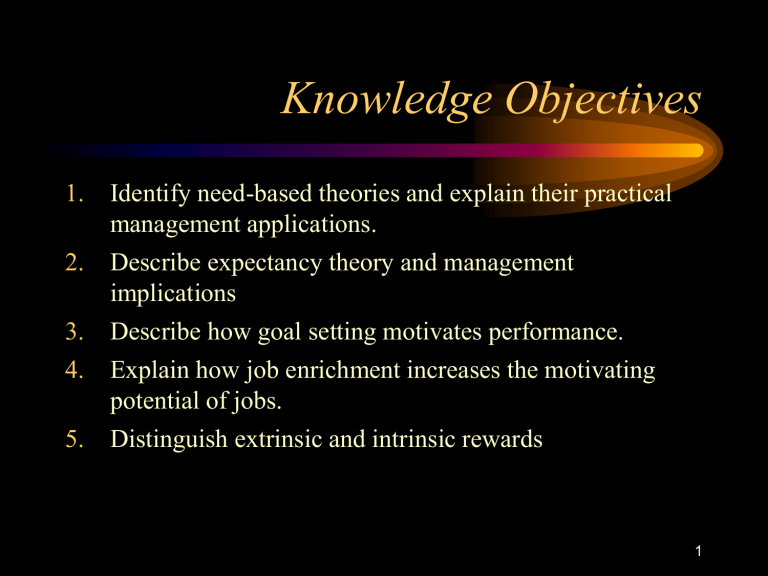
Knowledge Objectives
1.
Identify need-based theories and explain their practical management applications.
2.
Describe expectancy theory and management implications
3.
Describe how goal setting motivates performance.
4.
Explain how job enrichment increases the motivating potential of jobs.
5.
Distinguish extrinsic and intrinsic rewards
1
Motivation is a concept invented by people to help explain behavior
The concept is based on our personal understanding that behavior is the result of internal intentions and external factors
2
Motivation Theories
•
Theories of Motivation
–
Need Based
• Maslow (Need Hierarchy)
• Herzberg (Motivators & Hygiene Factors)
• McClelland (Power, Affiliation, Achievement)
–
Expectancy theory
–
Goal-setting theory
3
Motivation Theories (cont’d)
• Maslow’s Needs Hierarchy Theory
–
People have needs, and when one need is relatively fulfilled, other emerge in predictable sequence to take its place.
– Maslow’s hierarchy of needs
•
Physiological needs: food, water, sleep, and sex.
• Safety needs: safety from the elements and enemies.
• Love needs: desire for love, affection, and belonging.
• Esteem needs: self-perception as a worthwhile person.
• Self-actualization: becoming all that one can become.
4
Motivation Theories (cont’d)
• Relevance of Maslow’s Theory for
Managers
–
Beyond physical and safety needs, which higher order need will emerge cannot be predicted.
–
Fulfilled needs do not motivate .
– Effective managers anticipate individuals’ needs and provide opportunities for fulfillment.
– Satisfying esteem needs provides managers with greatest opportunity to motivate performance.
5
Motivation Theories (cont’d)
• Herzberg’s Two-Factor Theory
–
A theory of motivation based on job satisfaction.
–
Dissatisfiers - factors associated with the context of the job or work environment .
–
Satisfiers: factors associated with the nature of the task itself (job content).
6
Motivation Theories (cont’d)
• Implications of Herzberg’s Theory
–
Satisfaction is not the opposite of dissatisfaction.
–
Must think carefully about what motivates employees.
• Meaningful, interesting, and challenging (enriched) work
– Problems with theory
• Satisfaction- job performance link is at best weakly supported.
• One person’s dissatisfier is another person’s satisfier
7
(needs are not person-specific).
Motivation Theories (cont’d)
• McClelland’s Need Theories
–
High NAch individuals avoid high and low risk situations (e.g., achievement by chance and achievement without challenge)
– High NAff individuals prefer high contact social environments
– High NPow individuals prefer organizing the efforts of others
8
Useful Concept
•
Locus of Control (internal vs. external)
– belief that positive/negative outcomes are contingent upon his/her behavior
– result of prior learning
9
Motivation Theories (cont’d)
•
Expectancy Theory (Vroom)
–
Models the strength of motivation by perceived probabilities of success.
• Expectancy: one’s subjective belief or expectation that one thing will lead to another.
–
A basic expectancy model
• Motivational strength increases with probabilities of success for effort-performance and performancereward links, and the value attached to the reward.
[M = E * I * V]
10
Motivation Theories (cont’d)
•
Relevance of Expectancy Theory to
Managers
–
Expectations are influenced by managerial actions (e.g., reward systems and organizational support).
–
Training increases employee confidence in their effort-performance linkage.
– Listen for employees’ own perceived performance-reward probabilities.
11
Motivation Theories (cont’d)
•
Goal-Setting Theory
–
Goal setting: the process of improving performance with measurable outputs, objectives, deadlines, quality standards, etc..
•
A General Goal-Setting Model
–
Properly conceived goals trigger a motivational process that improves performance.
12
Motivation Theories (cont’d)
• Characteristics of effective goals:
• Specificity makes goals measurable.
•
Difficulty makes goals challenging.
• Participation gives personal ownership of the goal.
•
How Do Goals Actually Motivate?
– Goals are exercises in selective perception.
– Goals encourage effort to achieve something specific.
–
Goals encourage persistent effort.
– Goals foster creation of strategies and action plans.
13
Motivation Theories (cont’d)
•
Practical Implications of Goal-Setting
Theory
–
The ability to set goals can be transferred readily to any performance-based environment.
14
Motivation Through Job Design
•
Job Design
– The tasks required by organizational strategy, technology, and structure.
•
Strategy One: Do not change task
– If task cannot be changed - improve motivation through
•
Realistic job previews.
• Job rotation.
•
Limited exposure: Using incentive such as contingent time off (CTO) to motivate performance.
15
Motivation Through Job Design
(cont’d)
•
Strategy Two: Change Task
–
Job enlargement: combining two or more specialized tasks (horizontal loading) to increase motivation.
– Job enrichment: redesigning a job to increase its motivating potential by introducing planning and decision-making responsibility (vertical loading) “Re-Skilling”.
16
Motivation Through Job Design
(cont’d)
•
Core Dimensions of Work
–
Skill variety: the variety of activities required in carrying out the work.
– Task identity: the completion of a “whole” and identifiable piece of work.
–
Task significance: how substantial an impact the job has on the lives of other people.
–
Autonomy: the freedom, independence, and discretion that one has to do the job.
–
Job feedback: how much performance feedback the job provides to the worker.
17
Motivation Through Rewards
•
Extrinsic Rewards
–
Payoffs granted to the individual by other rewards.
•
Money, employee benefits, promotions, recognition, status symbols, and praise.
•
Intrinsic Rewards
–
Self-granted and internally experienced payoffs.
•
Sense of accomplishment, self-esteem, and selfactualization.
18
Motivation Through Rewards
(cont’d)
•
Improving Performance with Extrinsic
Rewards
–
Rewards must satisfy individual needs.
• Cafeteria compensation: a plan that allows employees to select their own mix of benefits.
– Employees must believe effort will lead to reward.
–
Rewards must be equitable.
–
Rewards must be linked to performance.
19

